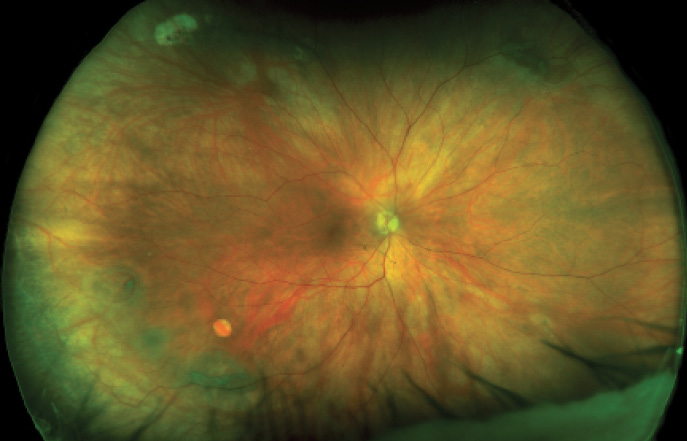Could the eye’s retina play a significant role in the early detection of Alzheimer’s disease?
A recently published article suggests “yes,” and optometrist Deborah Zelinsky OD, founder and researcher of the Mind-Eye Institute in Northbrook, Illinois, agrees with study findings. “An increasing amount of new research supports the significant role the retina plays in the detection and early diagnosis of disease,” she says.
A world-renowned expert on retinal processing and the impact of the retina on brain function, Dr. Zelinsky has long contended “changes in the retina reflect changes in the brain. We know that, through the eye, we can evaluate the body’s microvascular and neurosensory systems, finding evidence of hypertension, diabetes, colon cancer, and even presence of neurodegenerative disorders like Alzheimer’s and Parkinson’s disease.”
During a presentation at the World Pharma 2023 Conference, held in March 2023, Dr. Zelinsky explained that many neurotransmitters, like dopamine, acetylcholine, glycine, serotonin, and glutamate, are found in the retina. Any imbalances in these elements can lead to a variety of symptoms, including sleeping problems; learning, concentration, and memory difficulties; and/or biochemical disorders, like depression, anxiety, mood dysregulation, and schizophrenia.
The latest published analysis of the retina underscores Dr. Zelinsky’s comments. In a 2023 issue of Acta Neuropathologica, scientists, led by senior investigator Maya Koronyo-Hamaoui PhD, of Cedars-Sinai Medical Center in Los Angeles, conclude the retina is “susceptible” to Alzheimer’s disease processes, “including molecular, cellular, and structural abnormalities that can be detected in the earliest stages of functional impairment. Furthermore, [the] study has identified the pathological connections between the retina, brain, and cognition, proposing that the retina could serve as a reliable biomarker for non-invasive AD (Alzheimer’s disease) detection and monitoring.”
Dr. Koronyo-Hamaoui was recognized by the Society for Brain Mapping and Therapeutics (SBMT) in 2013, earning The Pioneer in Medicine Award. The honor is presented to individuals who, according to the SBMT, “have contributed significantly to scientific advancement in the fields of medicine and image-guided therapy through a multidisciplinary approach. Their groundbreaking contributions have made development of state-of-the-art technology and scientific discovery a reality.”
Dr. Zelinsky also is a member of the SBMT (currently serving as the organization’s president), where she says she is “privileged to brainstorm with people like Dr. Koronyo-Hamaoui.” The SBMT is at the forefront of research, recognizing scientists and other professionals who have demonstrated innovative ideas and approaches.
In an article on the Cedars-Sinai website, Dr. Koronyo-Hamaoui explains how the retinal study team found an “accumulation of highly toxic proteins in the retinas of patients with Alzheimer’s disease and mild cognitive impairment, causing severe degeneration of cells.” Those toxic elements included an “overabundance of a protein called amyloid beta 42, which in the brains of Alzheimer’s disease patients clumps together to form plaques that disrupt brain function.” The amyloid protein collected in the eye’s ganglion cells – “the cells that bridge visual input from the retina to the optic nerve,” Dr. Koronyo-Hamaoui is quoted as saying in the online article.
Current year (2023) statistics indicate approximately 6.7 million Americans are living with Alzheimer’s disease, the Alzheimer’s Association reports. One in three senior citizens will die of Alzheimer’s or other form of dementia.
“When normal brain function is disrupted by injury or disease, retinal activity also is likely affected. The study in Acta Neuropathologica demonstrates just such a correlation – a finding certainly not surprising. The retina is composed of brain tissue and is part of the central nervous system. The eye and its retina offer us a window to the brain, and that window is proving increasingly effective in detecting disease noninvasively — even before the patient manifests symptoms. Earlier diagnosis, of course, means earlier treatment,” Dr. Zelinsky says.
At the Mind-Eye Institute, Dr. Zelinsky and her team use therapeutic eyeglasses, filters, and other optometric interventions to vary the amount, intensity, and angle of light on the retina. Retinal cells generate electrical signals, which propagate through neurons and interact with critical brain structures. These signals affect not just the visual cortex for eyesight but other, significant regions of the brain as well.
“The right mix of prescriptive lenses, filters and prisms affects the spatial and temporal distribution of light on the retina, thereby modifying the dynamic relationship between the mind’s visual inputs and the body’s internal reactions and responses. The implication is that retinal stimulation with light can intentionally promote customized changes in a patient’s basic physical, physiological, and even psychological systems involved in metabolism, motor control, posture, mood, circadian rhythm, and decision-making abilities,” Dr. Zelinsky indicates.
Indeed, these “customized changes” to the brain are what oftentimes bring relief to patients experiencing the headaches, brain fog, concentration and attention problems, sleep disorders, and concentration difficulties due to brain injury or neurological abnormalities and disease.
“Research continues to show that retinal stimulation using light represents a powerful approach to early diagnosis,” Dr. Zelinsky notes. “The eye is linked to numerous neural processes and systems in the body, which is why retinal stimulation through advanced optometry is quickly becoming a promising method for modulating brain function.”

Research, Additional Research
Changes in Retina Can Indicate Alzheimer’s Disease
Study Supports Mind-Eye Contention That Retina Mirrors Brain Health
